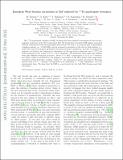Files in this item
Emergent Weyl fermion excitations in TaP explored by 181Ta quadrupole resonance
Item metadata
| dc.contributor.author | Yasuoka, H. | |
| dc.contributor.author | Kubo, T. | |
| dc.contributor.author | Kishimoto, Y. | |
| dc.contributor.author | Kasinathan, D. | |
| dc.contributor.author | Schmidt, M. | |
| dc.contributor.author | Yan, B. | |
| dc.contributor.author | Zhang, Y. | |
| dc.contributor.author | Tou, H. | |
| dc.contributor.author | Felser, C. | |
| dc.contributor.author | Mackenzie, A. P. | |
| dc.contributor.author | Baenitz, M. | |
| dc.date.accessioned | 2017-07-17T10:30:10Z | |
| dc.date.available | 2017-07-17T10:30:10Z | |
| dc.date.issued | 2017-06-09 | |
| dc.identifier | 250365506 | |
| dc.identifier | 6464fe0b-be51-4732-8c82-7063f53eb9e3 | |
| dc.identifier | 000402979400011 | |
| dc.identifier | 85020468533 | |
| dc.identifier.citation | Yasuoka , H , Kubo , T , Kishimoto , Y , Kasinathan , D , Schmidt , M , Yan , B , Zhang , Y , Tou , H , Felser , C , Mackenzie , A P & Baenitz , M 2017 , ' Emergent Weyl fermion excitations in TaP explored by 181 Ta quadrupole resonance ' , Physical Review Letters , vol. 118 , no. 23 , 236403 . https://doi.org/10.1103/PhysRevLett.118.236403 | en |
| dc.identifier.issn | 0031-9007 | |
| dc.identifier.uri | https://hdl.handle.net/10023/11222 | |
| dc.description | T. K., Y. K., and H. T. appreciate the financial support from JSPS KAKENHI Grants (No. 15K21732 and No. 15H05885). D. K. acknowledges funding via FOR 1346 from the Deutsche Forschungsgemeinschaft. | en |
| dc.description.abstract | The 181Ta quadrupole resonance [nuclear quadrupole resonance (NQR)] technique is utilized to investigate the microscopic magnetic properties of the Weyl semimetal TaP. We find three zero-field NQR signals associated with the transition between the quadrupole split levels for Ta with I=7/2 nuclear spin. A quadrupole coupling constant, νQ=19.250 MHz, and an asymmetric parameter of the electric field gradient, η=0.423, are extracted, in good agreement with band structure calculations. In order to examine the magnetic excitations, the temperature dependence of the spin-lattice relaxation rate (1/T1T) is measured for the f2 line (±5/2↔±3/2 transition). We find that there exist two regimes with quite different relaxation processes. Above T∗≈30 K, a pronounced (1/T1T) α T2 behavior is found, which is attributed to the magnetic excitations at the Weyl nodes with temperature-dependent orbital hyperfine coupling. Below T∗, the relaxation is mainly governed by a Korringa process with 1/T1T=const, accompanied by an additional T-1/2-type dependence to fit our experimental data. We show that Ta NQR is a novel probe for the bulk Weyl fermions and their excitations. | |
| dc.format.extent | 6 | |
| dc.format.extent | 1598881 | |
| dc.language.iso | eng | |
| dc.relation.ispartof | Physical Review Letters | en |
| dc.subject | QC Physics | en |
| dc.subject | TK Electrical engineering. Electronics Nuclear engineering | en |
| dc.subject | Physics and Astronomy(all) | en |
| dc.subject | NDAS | en |
| dc.subject.lcc | QC | en |
| dc.subject.lcc | TK | en |
| dc.title | Emergent Weyl fermion excitations in TaP explored by 181Ta quadrupole resonance | en |
| dc.type | Journal article | en |
| dc.contributor.institution | University of St Andrews. School of Physics and Astronomy | en |
| dc.contributor.institution | University of St Andrews. Condensed Matter Physics | en |
| dc.identifier.doi | 10.1103/PhysRevLett.118.236403 | |
| dc.description.status | Peer reviewed | en |
| dc.identifier.url | https://journals.aps.org/prl/supplemental/10.1103/PhysRevLett.118.236403 | en |
This item appears in the following Collection(s)
Items in the St Andrews Research Repository are protected by copyright, with all rights reserved, unless otherwise indicated.

